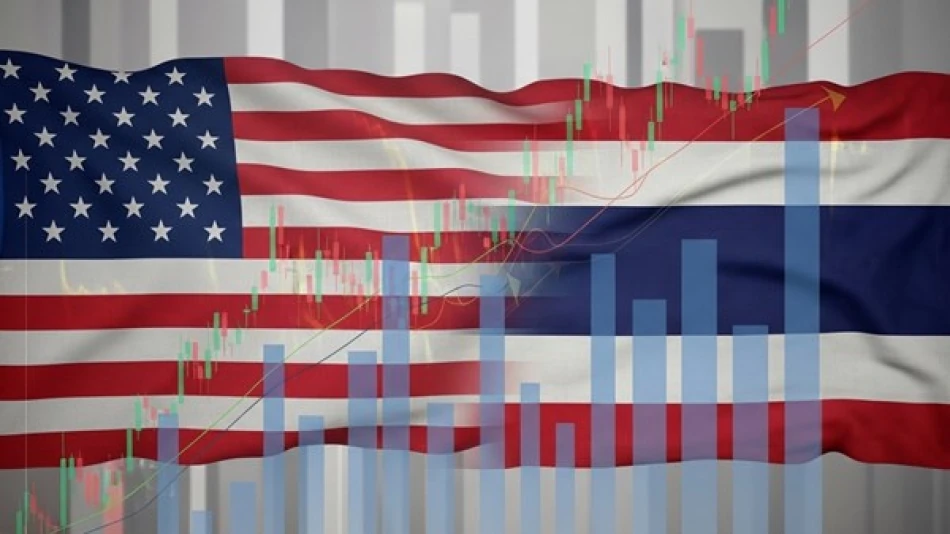
Thailand Secures Major Breakthrough in US Trade Tariff Negotiations
US Slashes Thailand Tariffs as Trade War Tactics Shift to Regional Diplomacy
The United States has agreed to reduce tariffs on Thai exports from 36% to 19%, marking a significant diplomatic victory for Thailand and signaling a potential shift in American trade strategy toward Southeast Asia. The move comes amid broader geopolitical tensions and suggests Washington is prioritizing regional stability over aggressive trade enforcement in key Asian markets.
Thailand Secures Major Trade Concession
Thai government spokesperson Jirayu Houngsub announced the tariff reduction in an official statement, describing it as "one of the main achievements of Team Thailand" in securing a win-win approach that protects the country's export base and long-term economic security. The new 19% rate aligns Thailand with tariff levels applied to several other Southeast Asian nations, creating a more level playing field in the region.
The agreement represents a substantial improvement for Thai exporters, who had been facing punitive tariffs that made their goods significantly less competitive in the crucial American market. While the government has not disclosed specific details of Thailand's latest negotiating offer, the successful outcome suggests Bangkok made meaningful concessions to secure the reduction.
Geopolitical Timing Reveals Strategic Priorities
The tariff announcement comes just days after Thailand and Cambodia agreed to a ceasefire following nearly a week of deadly border clashes that killed at least 41 people. This timing is no coincidence—reports indicate the trade agreement emerged under direct pressure from Washington, with former President Donald Trump reportedly stating he would not continue pursuing trade deals while the regional conflict persisted.
This linkage between trade policy and regional security demonstrates how the US increasingly views economic tools as extensions of diplomatic strategy, particularly in Southeast Asia where China's influence continues to grow. By offering trade incentives contingent on peaceful behavior, Washington is effectively using market access as a carrot to promote stability.
Broader Tariff Restructuring Signals Policy Shift
Thailand's success is part of a wider recalibration of US tariff policy affecting multiple countries. Lesotho, which faced threats of 50% tariffs, will now see rates of just 15%. Taiwan faces 20% tariffs, while Pakistan joins Thailand at 19%. Meanwhile, imports from Iceland, Fiji, Ghana, Guyana, and Ecuador will be subject to 15% duties.
This tiered approach suggests the US is moving away from blanket protectionist measures toward a more nuanced system that considers geopolitical relationships, regional stability, and strategic partnerships. Countries that align with US security interests or demonstrate cooperative behavior appear to be rewarded with more favorable trade terms.
Market Implications and Regional Competition
For Thai exporters, the tariff reduction provides immediate relief and improved competitiveness against regional rivals. Industries ranging from textiles to electronics should see enhanced market access, potentially boosting Thailand's export-dependent economy. The country's stock market and currency are likely to benefit from improved trade prospects and reduced uncertainty.
However, the 19% rate still represents a significant burden compared to pre-trade war levels, when many Thai goods entered the US market with minimal tariffs. This suggests that while relations are improving, the era of frictionless trade remains in the past.
The differential treatment of various countries also creates new competitive dynamics. Taiwan's higher 20% rate may reflect ongoing US-China tensions and Washington's complex relationship with the island, while the uniform 15% rate for smaller economies suggests a baseline level for nations with limited strategic importance.
Long-term Strategic Calculations
Thailand's success in securing tariff relief while maintaining its traditional policy of regional neutrality demonstrates sophisticated diplomatic maneuvering. Unlike countries that have been forced to choose sides in US-China competition, Thailand has managed to extract concessions from Washington while avoiding direct confrontation with Beijing.
This approach may serve as a model for other middle powers seeking to navigate great power competition without sacrificing economic interests. The key appears to be demonstrating value to US strategic interests—in Thailand's case, regional stability and conflict resolution—while maintaining flexibility in other relationships.
Most Viewed News

 Layla Al Mansoori
Layla Al Mansoori






